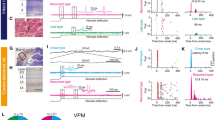Abstract
It was shown during experiments on unrestrained rats that rhythmic stimulation of the pyramidal tract produced a statistically significant increase in the functional activity of neuronal populations of the sensorimotor cortex, manifesting as potentiation of the primary, positive phase of pyramidal cortical response. Combined rhythmically matched stimulation of the pyramidal tract and of the lateral hypothalamus leads to statistically significant enhancement in potentiation of the positive phase of pyramidal cortical response compared with effects produced independently of hypothalamic involvement. When stimulation of the pyramidal tract and the lateral hypothalamus are combined with stimulation applied at the same periodicity to the sensorimotor cortex, a further statistically significant enhancement in potentiation of the positive phase of pyramidal cortical response is seen in addition to the potentiating effect produced by hypothalamic stimulation.
Similar content being viewed by others
Literature cited
P. K. Anokhin, Biology and Neurophysiology of Conditioned Reflexes [in Russian], Meditsina, Moscow (1968).
V. A. Badikov and K. V. Sudakov, "Establishing of food response during direct hypothalamic electrical stimulation," in: General Neurophysiology and Experimental Pathology of the Nervous System [in Russian], Meditsina, Moscow (1968), pp. 9–11.
R. Buresh, M. Petran', and I. Zakhar, Electrical Research Techniques [Russian translation], Inostr. Lit, Moscow (1962).
A. A. Volokhov and I. A. Shimko, "Effects of early motor training on evoked potentials in the rat visual and sensorimotor cerebral cortex," Zh. Vyssh. Nervn. Deyat., im. I. P. Pavlova;28, No. 6, 1288 (1978).
L. L. Voronin and V. A. Markevich, Analog of conditioned reflex; recording of pyramidal track response to direct cortical stimulation," Dokl. Akad. Nauk SSSR,253, No. 4, 1005–1009 (1980).
E. Gelhorn and G. Loughborough, Emotions and Emotional Disturbances [Russian translation], Mir, Moscow (1966).
L. V. Kalyuzhnyi, "Changes in evoked potential during different motivational responses in rabbits," Dokl. Akad. Nauk SSSR,189, No. 3, 674–677 (1969).
M. P. Klyavina and V. G. Kassil', "Effects of stimulating hypothalamic ‘reward’ and ‘punishment’ zones on evoked potentials in the auditory cortex," Prob. Fiziol. Gipotal., No. 18, 19–24 (1984).
T. N. Oniani, M. G. Koridze, P. P. Mol'nar, and A. A. Ungaedze, "Synchronization of cortical activity in anesthetized cats during high-frequency stimulation of the medial and diencephalic brain structures," in: Neurophysiology of the Emotions and the Sleep-Wake Cycle, Vol. 2, [in Russian], Metsiniereba, Tbilisi (1975), pp. 181–185.
V. N. Provodina, "Changes in primary response within the focusing range of the visual cortex under the effects of anterior and posterior hypothalamic stimulation," Tr. Inst. Norm. Patol. Fiziol. Akad. Med. Nauk SSSR,13, 65–66 (1970).
V. M. Storozhuk, Functional Organization of Somatic Cortex Neurons [in Russian], Naukova Dumka, Kiev (1974).
I. A. Shimko, "Evoked potentials in the sensorimotor cortex and the caudate nucleus in rats during intensive early training in food labyrinths," Zh. Vyssh. Nervn. Deyat. im. I. P. Pavlova,32, No. 6, 1149–1155 (1982).
A. Baranyi and O. Feher, "Conditioned changes of synaptic transmission in the motor cortex of the cat," Exp. Brain Res.,33, No. 2, 283–298 (1978).
L. J. Bindman, O. C. J. Lippold, and A. R. Milne, "Prolonged changes in excitability of pyramidal tract neurons in the cat: a postsynaptic mechanism," J. Physiol.,286, 457–477 (1979).
H.-T. Chang, "Cortical response to stimulation of medullary pyramid in rabbit," J. Neurophysiol.,18, No. 4, 332–352 (1955).
A. L. F. Gorman and H. Silfvenius, "The effects of local cooling of the cortical surface of the motor cortex response following stimulation of the pyramidal tract," Electroencephalogr. Clin. Neurophysiol.,23, No. 4, 360–370 (1967).
D. R. Humphry, "Re-analysis of the antidromic cortical response. 1. Potentials evoked by stimulation of the isolated pyramidal tract," Electroencephalogr. Clin. Neurophysiol.,24, No. 2, 116 (1968).
D. R. Humphry, "Re-analysis of the antidromic cortical response. 2. On the contribution of cell discharge and PSPs to the evoked potentials," Electroencephalogr. Clin. Neurophysiol.,25, No. 5, 421–442 (1968).
S. J. Jabbur and A. L. Towe, "Analysis of the antidromic cortical response following stimulation of the medullary pyramids," J. Physiol.,155, No. 1, 148–160 (1961).
C. C. Kuenzle and A. Knüsel, "Mass training of rats in a superenriched environment," Physiol. Behav.,13, No. 2, 205–210 (1974).
W. M. Landau, "An analysis of the cortical response to antidromic pyramidal tract stimulation in the cat," Electroencephalogr. Clin. Neurophysiol.,8, No. 3, 445–456 (1956).
R. Porter and J. H. Sanderson, "Antidromic cortical response to pyramidal tract stimulation in the rat," J. Physiol.,170, No. 3, 355–370.
M. R. Rosenzweig, E. L. Bennett, and M. C. Diamond, "Chemical and anatomical plasticity of brain: replications and extensions," in: Macromolecules and Behavior, J. Gaito, editor, New York (1972), p. 205.
M. R. Rosenzweig, E. L. Bennett, M. Herbert, and H. Morimoto, "Special grouping cannot account for cerebral effects of enriched environments," Brain Res.,153, No. 3, 363 (1978).
B. Sadowski, and V. G. Longo, "Electroencephalographic and behavioral correlates of instrumental reward conditioned response in rabbits," Electroencephalogr. Clin. Neurophysiol.,14, No. 4, 465–476 (1962).
L. L. Voronin and S. V. Ioffe, "Changes in unit postsynaptic responses at sensorimotor cortex with conditioning in rabbits," Acta Neurobiol. Exp.,34, No. 4, 505–513 (1974).
B. L. Welch, D. G. Brown, A. S. Welch, and D. C. Lin, "Isolation, restrictive confinement or crowding of rats for one year. 1. Weight, nucleic acids and protein of brain regions," Brain Res.,75, No. 1, 71 (1974).
C. D. Woody and P. Black-Cleworth, "Differences in excitability of cortical neurons as a function of motor projection in conditioned cats," J. Neurophysiol.,36, No. 6, 1104–1116 (1973).
Additional information
Institute for Brain Research of the All-Union Scientific Center of Mental Health, Academy of Medical Sciences of the USSR, Moscow. Translated from Neirofiziologiya, Vol. 18, No. 3, pp. 367–373, May–June, 1986.
Rights and permissions
About this article
Cite this article
Shimko, I.A. Modulation of pyramidal response in the rat sensorimotor cortex after combined stimulation of the lateral hypothalamus and the sensorimotor cortex. Neurophysiology 18, 272–277 (1986). https://doi.org/10.1007/BF01052548
Received:
Issue Date:
DOI: https://doi.org/10.1007/BF01052548



